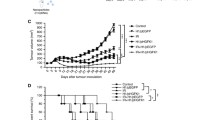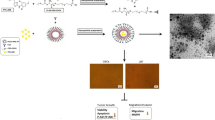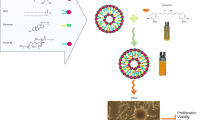Abstract
In recent years, targeted delivery systems have been used along with combinatorial therapy to decrease drug resistance and increase cancer therapy efficacy. The anti-proliferative effects of vitamin D3 (VD3) on cancerous cells, such as C6 glioma, with active hedgehog pathways raised the question as to whether pre-targeting C6 glioma cells with VD3-loaded nanoparticles (VD3NPs) can enhance the anti-tumor effects of doxorubicin, epirobicin, and docetaxel on this drug-resistant cell line. Here, studying at cellular, nuclear, protein, and gene levels we demonstrated that VD3NP-doxorubicin and VD3NP-epirobicin combinations increased the probability of chemotherapy/radiotherapy resistance and cancer stem cell (CSC) properties in C6 glioma significantly (P < 0.05), compared to doxorubicin and epirobicin alone. However, VD3NP-docetaxel combination may have the potential in sensitizing C6 cells to ionizing irradiation, but this combination also increased the CSC properties and the probability of drug resistance significantly (P < 0.05), compared to docetaxel alone. Although our previous study showed that targeted delivery of VD3 reduced the rate of proliferation significantly (P < 0.05) in C6 glioma cells (a drug-resistant cell line), here we concluded that combinatorial therapy of exogenous VD3 with doxorubicin, epirobicin, and docetaxel not only did not lead to the enhancement of cytotoxic effects of the aforementioned drugs but also increased the cancerous characteristics in C6 glioma, in vitro.




Similar content being viewed by others
References
Albert B, Hahn H (2014) Interaction of hedgehog and vitamin D signaling pathways in basal cell carcinomas. Adv Exp Med Biol 810:329–341
Angelastro JM, Lamé MW (2010) Overexpression of CD133 promotes drug resistance in C6 glioma cells. Mol Cancer Res 8:1105–1115
Autier P, Gandini S (2007) Vitamin D supplementation and total mortality: a meta-analysis of randomized controlled trials. Arch Intern Med 167:1730–1737
Baek S, Lee Y-S, Shim H-E, Yoon S, Baek S-Y, Kim B-S, et al. (2011) Vitamin D3 regulates cell viability in gastric cancer and cholangiocarcinoma. Anat Cell Biol 44:204–209
Balasubramanian S, Lee K, Adhikary G, Gopalakrishnan R, Rorke EA, Eckert RL (2008) The Bmi-1 polycomb group gene in skin cancer: regulation of function by (−)-epigallocatechin-3-gallate. Nutr Rev 66:S65–SS8
Colston KW, Lowe LC, Mansi JL, Campbell MJ (2006) Vitamin D status and breast cancer risk. Anticancer Res 26:2573–2580
Conde J, de la Fuente JM, Baptista PV (2013) Nanomaterials for reversion of multidrug resistance in cancer: a new hope for an old idea? Front Pharmacol 4:134
Cross HS, Bises G, Lechner D, Manhardt T, Kallay E (2005) The vitamin D endocrine system of the gut—its possible role in colorectal cancer prevention. J Steroid Biochem Mol Biol 97:121–128
DeBerardinis AM, Banerjee U, Hadden MK (2013) Identification of vitamin D3-based hedgehog pathway inhibitors that incorporate an aromatic A-ring isostere. ACS Med Chem Lett 4:590–595
Dormoy V, Beraud C, Lindner V, Coquard C, Barthelmebs M, Brasse D, et al. (2012) Vitamin D3 triggers antitumor activity through targeting hedgehog signaling in human renal cell carcinoma. Carcinogenesis 33:2084–2093
Feskanich D, Ma J, Fuchs CS, Kirkner GJ, Hankinson SE, Hollis BW, et al. (2004) Plasma vitamin D metabolites and risk of colorectal cancer in women. Cancer Epidemiol Biomark Prev 13:1502–1508
Flanagan JN, Young MV, Persons KS, Wang L, Mathieu JS, Whitlatch LW, et al. (2006) Vitamin D metabolism in human prostate cells: implications for prostate cancer chemoprevention by vitamin D. Anticancer Res 26:2567–2572
Giovannucci E (2011) The epidemiology of vitamin D and cancer risk. In: Adams DFWPS (ed) Vitamin D (third edition). Academic, San Diego, pp. 1569–1590
Guan X (2015) Cancer metastases: challenges and opportunities. Acta Pharm Sin B 5:402–418
Hu Y, Fu L (2012) Targeting cancer stem cells: a new therapy to cure cancer patients. Am J Cancer Res 2:340–356
Kolter T, Sandhoff K (2006) Sphingolipid metabolism diseases. BBA - Biomembranes 1758:2057–2079
Konety BR, Lavelle JP, Pirtskalaishvili G, Dhir R, Meyers SA, Nguyen T-ST, et al. (2013) Effects of vitamin D (calcitriol) on translational cell carinoma of the bladder in vitro and in vivo. J Urol 165:253–258
Krishnan AV, Feldman D (2011) Vitamin D and prostate cancer. Exp Biol Med:1675–1709
Maleklou N, Allameh A, Kazemi B (2015) Preparation, characterization and in vitro-targeted delivery of novel apolipoprotein E-based nanoparticles to C6 glioma with controlled size and loading efficiency. J Drug Target:1–11
Markman JL, Rekechenetskiy A, Holler E, Ljubimova JY (2013) Nanomedicine therapeutic approaches to overcome cancer drug resistance. Adv Drug Deliv Rev 65:1866–1879
Messmer UK, Brune B (1997) Attenuation of p53 expression and Bax down-regulation during phorbol ester mediated inhibition of apoptosis. Br J Pharmacol 121:625–634
Mohr SB, Gorham ED, Kim J, Hofflich H, Garland CF (2014) Meta-analysis of vitamin D sufficiency for improving survival of patients with breast cancer. Anticancer Res 34:1163–1166
Naviaux RK, Baker D (2015) Diagnostic and predictive metabolite patterns for disorders affecting the brain and nervous system. Google Patents
Pattabiraman DR, Weinberg RA (2014) Tackling the cancer stem cells—what challenges do they pose? Nat Rev Drug Discov 13:497–512
Pawlik TM, Keyomarsi K (2004) Role of cell cycle in mediating sensitivity to radiotherapy. Int J Radiat Oncol Biol Phys 59:928–942
Peehl DM, Krishnan AV, Feldman D (2003) Pathways mediating the growth-inhibitory actions of vitamin D in prostate cancer. J Nutr 133:2461S–2469S
Pfaffl MW, Horgan GW, Dempfle L (2002) Relative expression software tool (REST) for group-wise comparison and statistical analysis of relative expression results in real-time PCR. Nucleic Acids Res 30:36–38
Sinclair WK, Morton RA (1966) X-ray sensitivity during the cell generation cycle of cultured Chinese hamster cells. Radiat Res 29:450–474
Stockert JC, Blazquez-Castro A, Canete M, Horobin RW, Villanueva A (2012) MTT assay for cell viability: intracellular localization of the formazan product is in lipid droplets. Acta Histochem 114:785–796
Tahannejad Z, Dayer D, Samie M (2012) The levels of serum alkaline phosphatase and lactate dehydrogenase in Hodgkin lymphoma. IJBC 4:125–128
Trump DL, Muindi J, Fakih M, WD Y, Johnson CS (2006) Vitamin D compounds: clinical development as cancer therapy and prevention agents. Anticancer Res 26:2551–2556
Urrutia-Pereira M, Solé D (2015) Vitamin D deficiency in pregnancy and its impact on the fetus, the newborn and in childhood. Rev Paul Pediatr 33:104–113
Wang JF, Liu Y, Liu WJ, He SY (2010) Expression of Bmi-1 gene in esophageal carcinoma cell EC9706 and its effect on cell cycle, apoptosis and migration. Chin J Cancer 29:689–696
Acknowledgments
This paper is a part of the PhD thesis of Nargess Maleklou, PhD student of Medical Nanotechnology of Shahid Beheshti University of Medical Science (SBMU). Experiments were performed at the Cellular and Molecular Biology Research Center in SBMU. All financial budgets were provided by SBMU. We would like to thank Dr. Nariman Mosaffa, and Dr. Mojgan Bandehpour for their precise consultation, especially in cell biology.
Author information
Authors and Affiliations
Corresponding authors
Ethics declarations
Conflict of interest
The authors declare that they have no conflict of interest.
Additional information
Editor: Tetsuji Okamoto
Rights and permissions
About this article
Cite this article
Maleklou, N., Allameh, A. & Kazemi, B. Targeted delivery of vitamin D3-loaded nanoparticles to C6 glioma cell line increased resistance to doxorubicin, epirubicin, and docetaxel in vitro. In Vitro Cell.Dev.Biol.-Animal 52, 989–1000 (2016). https://doi.org/10.1007/s11626-016-0072-7
Received:
Accepted:
Published:
Issue Date:
DOI: https://doi.org/10.1007/s11626-016-0072-7




